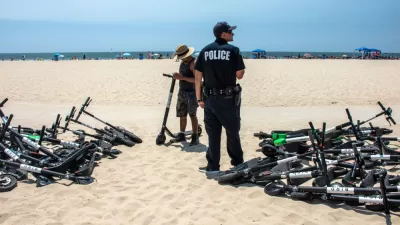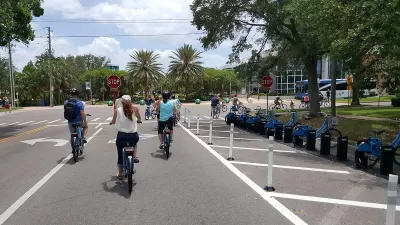New data from National Association of City Transportation Officials (NACTO) shows the number of rides on electric scooters and shared bikes rising by 60 percent between 2018 and 2019.

"Shared bikes and e-scooters saw 136 million trips in 2019, up 60% from 2018, according to new figures released by the National Association of City Transportation Officials (NACTO)," reports Chris Teale.
Of those trips, most were short. In 2019, micromobility trips averaged between 11 and 12 minutes and 1 to 1.5 miles in distance. "The organization said those figures are key as 35% of car trips in the U.S. are less than 2 miles, so shifting more trips to bikes and scooters could help ease issues like congestion, road safety and emissions," according to Teal.
Like every other transportation mode, micromoblility ridership has declined dramatically during the pandemic, so similar numbers won't be possible. But, as made clear an article explaining the findings of the new report posted on the organization's website, NACTO believes that microbobility will outlast the pandemic with continued support from local and state governments.
Over the past decade, and especially in 2020, we’ve also seen that the most successful systems are the ones where there is strong, reliable partnership between the city and operator. These partnerships create and support equitable distribution requirements, free and reduced fees for essential workers, and general system reliability, and other policies that are essential to meet city health, equity, mobility, sustainability, and resilience goals.
FULL STORY: Micromobility 'here to stay' despite COVID setbacks: NACTO

Maui's Vacation Rental Debate Turns Ugly
Verbal attacks, misinformation campaigns and fistfights plague a high-stakes debate to convert thousands of vacation rentals into long-term housing.

Planetizen Federal Action Tracker
A weekly monitor of how Trump’s orders and actions are impacting planners and planning in America.

Chicago’s Ghost Rails
Just beneath the surface of the modern city lie the remnants of its expansive early 20th-century streetcar system.

Bend, Oregon Zoning Reforms Prioritize Small-Scale Housing
The city altered its zoning code to allow multi-family housing and eliminated parking mandates citywide.

Amtrak Cutting Jobs, Funding to High-Speed Rail
The agency plans to cut 10 percent of its workforce and has confirmed it will not fund new high-speed rail projects.

LA Denies Basic Services to Unhoused Residents
The city has repeatedly failed to respond to requests for trash pickup at encampment sites, and eliminated a program that provided mobile showers and toilets.
Urban Design for Planners 1: Software Tools
This six-course series explores essential urban design concepts using open source software and equips planners with the tools they need to participate fully in the urban design process.
Planning for Universal Design
Learn the tools for implementing Universal Design in planning regulations.
planning NEXT
Appalachian Highlands Housing Partners
Mpact (founded as Rail~Volution)
City of Camden Redevelopment Agency
City of Astoria
City of Portland
City of Laramie





























